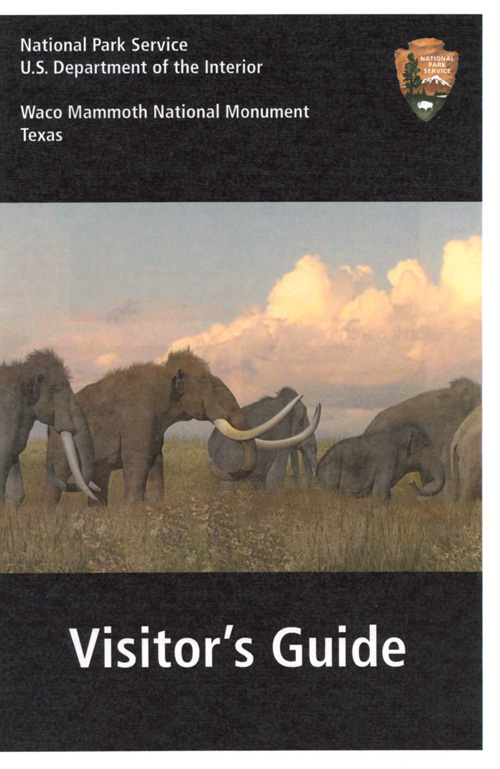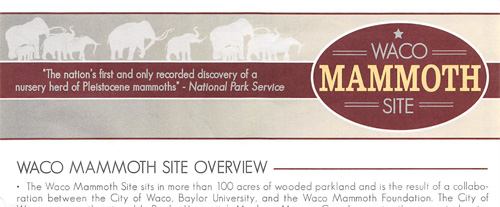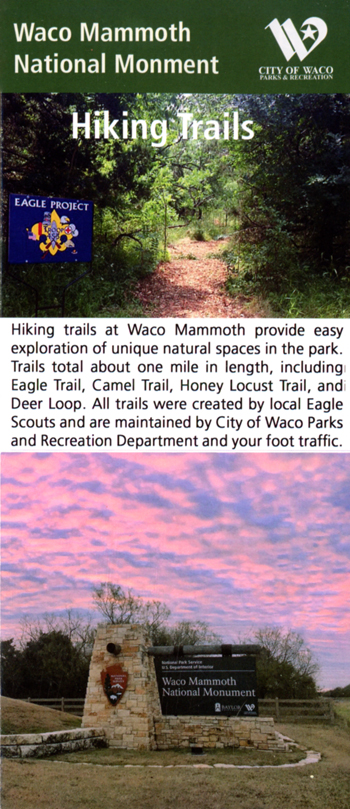|
Waco Mammoth National Monument Texas |
 |
 NPS photo | |
You can almost hear them, and sense the rain coming, says Ellie Caston, who helped preserve this mammoth site in Waco, Texas. She is imagining the first group of Columbian mammoths found here as they were 65,000 years ago, as adult females surrounding their young. Like today’s elephants, the adults encircled the young to protect them. But on that long-ago day, they all died.
Since the bones were discovered, scientists have been studying them and the surrounding area to find out what killed the animals. Maybe it was a flash flood from a storm, as Caston was thinking. Or perhaps it was a drought. These bones and their hidden stories led to establishing Waco Mammoth National Monument in 2015—a place where science and wonder come alive.
About 1.7 million years ago
Mammoths cross an ice bridge from Asia to North America. Two species develop in North America—the woolly mammoth and the Columbian mammoth.65,000 years ago
A nursery herd of Columbian mammoths dies in a ravine here. Layers of mud quickly cover their bones. Their fossils are discovered in 1978—the first mammoth nursery herd found in North America.Exact time unknown
Other animals die in the same area as the nursery herd. A saber-toothed cub is known only by its tooth. The others are unidentified, known only by a few bones.51,000 years ago
At least three mammoths die in the same area as the nursery herd. One is the only adult male Columbian mammoth that has been found as of 2018.Columbian mammoths were still roaming this area when humans arrived around 11,000 years ago. Mammoths died out around 10,000 years ago.
We were on to a once-in-a-lifetime discovery.
—Paul Barron
Paul Barron recalls how he and Eddie Bufkin felt in 1978 when they found a big fossil while exploring this area. They took it to Baylor University, where scientists recognized it as a leg bone of a Columbian mammoth.
The scientists organized an excavation, but kept the details secret to protect the site from poachers. They also protected the fossils by encasing them in plaster jackets. They lifted the jackets out of the pit and trucked them to safekeeping in Baylor’s museum storage. Those bones are still there in their plaster jackets. One day, scientists will have the time to study them and see what other stories they might tell.
BONES LEFT IN PLACE At Waco, many mammoth bones remain in situ—in their original positions. Some, like skulls and tusks, are easy to identify. All of them hold clues to life and death in the past.
WHERE THEY LIVED Mammoths lived when a continental ice sheet covered much of North America, 95,000 to 10,000 years ago. The Waco area climate, though, was warm all year. Columbian mammoths ranged south through Central America and north into colder areas—but not as far north as the smaller and hairier woolly mammoths.
Columbian Mammoth Mammuthus columbi A Columbian mammoth was born with tusks and a trunk, just like a modern elephant. It used these tools to gather food, dig for water, and defend itself and others in the herd. Its teeth were wide and flat, about the size of a shoebox. They could grind tough plants into digestible wads. Its wide, flat feet were cushioned by internal sponge-like pads. Such feet enabled an adult mammoth to walk for miles and miles like today’s elephants.
Texas During the Ice Ages
Columbian mammoths lived during the Pleistocene Epoch, a time also called the ice ages. The climate here was warm 65,000 years ago, not cold and icy. Mammoths roamed a vast area of grasslands and woodlands, along with other mammals like the camels, dire wolves, and saber-toothed cats shown above.
Fossils and other evidence at Waco show that a new glacial period was beginning around 50,000 years ago—the last great icy time before modern times. Grasses were still abundant, but cooler-weather plants became part of the mammoths’ diet too. It is rare to have so much evidence of a changing climate in one place. This is another reason why Waco Mammoth National Monument was established.
MAMMOTH STORIES These and other mammoth bones have been studied for years by scientists. Some show breaks, healed and unhealed, or provide clues to age and size. A camel skeleton was found with the mammoth bones. This might be a clue that predators were nearby. The dire wolf and saber-toothed cat often hunted camels but not bigger animals like mammoths.
CHANGING STORIES A few years ago, a geologist used a new technique to study the soil here. He learned the bones were twice as old as earlier estimates. Other geologists have found evidence for another idea about what killed the mammoths. Instead of a flood, it might have been a long drought.
AWAITING DISCOVERY What other ideas might emerge as scientists develop new tools for their work at this site? What new details will we learn about life during a time of great climate change? That's the excitement of science happening right here among the bones of long ago.
Visiting the Mammoths of Waco
 (click for larger map) |
Welcome! Everything you see here is thanks to the people of Waco, Texas, who worked over 35 years to protect this site. Now the National Park Service, the City of Waco, Baylor University, and the Waco Mammoth Foundation work in partnership to conduct research, run the welcome center, and offer tours and programs.
Waco Mammoth National Monument is open daily, 9 am–5 pm, except Thanksgiving, December 25, and January 1.
Start at the welcome center to sign up for a Dig Shelter tour, which is the only way to see the mammoth bones. A small fee is charged.
Other Things to Do
• Look for outdoor exhibits.
• Observe birds and butterflies.
• Take a walk.
• Enjoy a picnic.
• Try excavating a "fossil."
• Come to special events.
Come back often to enjoy new programs, trails, and opportunities as this new national monument develops.
Fees Tour fees are not covered by National Park passes. Call or check the park website for current fees. Children 3 or younger are free.
Weather In summer, bring plenty of water, wear a hat and sunscreen, bring insect repellent. In winter, be prepared for rain.
Pets Leashed pets are allowed on the grounds, but not on the tour. Do not leave pets in vehicles or tied up.
Firearms For firearms regulations check the park website.
Accessibility We strive to make our facilities, services, and programs accessible to all. For more information, call or check the park website.
Related Sites in Waco
Baylor University’s Mayborn Museum Complex
Find out more about natural and cultural history of central Texas. See
mammoth bones up close in a replica of the park’s excavation site. Fee.
Go to www.baylor.edu/mayborn.
Cameron Park, City of Waco
Enjoy miles of trails and views across the Brazos and Bosque rivers.
Visit the zoo to see the mammoth’s modern relatives—elephants. The
city park is free, but the zoo has a fee. For details about the city
park go to www.waco-texas.com/cms-parksandrecreation. For the
zoo, go to www.cameronparkzoo.com.
Source: NPS Brochure (2018)
|
Establishment Waco Mammoth National Monument — July 10, 2015 |
For More Information Please Visit The  OFFICIAL NPS WEBSITE |
Brochures ◆ Site Bulletins ◆ Trading Cards

Documents
Foundation Document, Waco Mammoth National Monument, Texas (September 2016)
Foundation Document Overview, Waco Mammoth National Monument, Texas (January 2016)
Junior Ranger Activity Book (Ages 5 and up), Waco Mammoth National Monument (Date Unknown; for reference purposes only)
Late Pleistocene mammoth herd structure, migration patterns, and Clovis hunting strategies inferred from isotropic analyses of multiple death assemblages (Kathryn A. Hoppe, extract from Paleobiology, Vol. 30 No. 1, 2004; ©The Paleontological Society)
Late Quaternary History of the Waco Mammoth Site: Environmental Reconstruction and Determining the Case of Death (©John D. Bongino, Master's Thesis, Baylor University, 2007)
Oral Memoirs of Paul M. Barron (Interviewed by Stephen M. Sloan, October 20, 2009; ©Baylor University Institute for Oral History 2015)
Proclamation 9299 — Establishment of the Waco Mammoth National Monument (Barack Obama, July 10, 2015)
Teacher's Guide: Waco Mammoth National Monument (Date Unknown)
Waco Mammoth Site Special Resource Study / Environmental Assessment (August 2008)
Waco Mammoth Site Special Resource Study Newsletter #1 (March 2006)
Waco Mammoth Site Special Resource Study Newsletter #2 (August 2007)
Books

waco/index.htm
Last Updated: 01-Aug-2024













